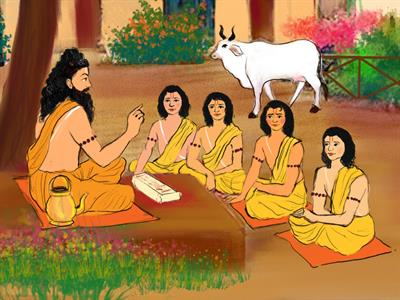PDF chapter test TRY NOW
ANCIENT EDUCATION SYSTEM IN INDIA — A WAY OF LIFE:
In ancient India, both formal and informal ways of education system existed. Indigenous education was imparted at home, in temples, pathshalas, tols, chatuspadis and gurukuls. There were people in homes, villages and temples who guided young children in imbibing pious ways of life. Temples were also the centres of learning and took interest in the promotion of knowledge of our ancient system. Students went to viharas and universities for higher knowledge. Teaching was largely oral and students remembered and meditated upon what was taught in the class.
Gurukuls, also known as ashrams, were the residential places of learning. Many of these were named after the sages. Situated in forests, in serene and peaceful surroundings, hundreds of students used to learn together in gurukuls. Women too had access to education during the early Vedic period. Among the prominent women Vedic scholars, we find references to Maitreyi, Viswambhara, Apala, Gargi and Lopamudra, to name a few.
During that period, the gurus and their shishyas lived together helping each other in day-to-day life. The main objective was to have complete learning, leading a disciplined life and realising one's inner potential. Students lived away from their homes for years together till they achieved their goals. The gurukul was also the place where the relationship of the guru and shishya strengthened with time. While pursuing their education in different disciplines like history, art of debate, law, medicine, etc., the emphasis was not only on the outer dimensions of the discipline but also on enriching inner dimensions of the personality.
Explanation:
Today, in this world of technological advancements, many people are opting for home schooling. This way, parents can have a good control over the child's learning and there is flexibility in timings. There are also parents who put their children in good boarding schools, as they are not able to be present with them. Similarly, the ancient education system had both formal and informal ways of acquiring education. There are certain things that cannot be taught and only be imbibed. Children acquired knowledge on pious and religious ways of life from elders who were within the family or society. Students learnt many art forms or skills in an informal way from mere observation and listening to experienced people's wise words. Most of this learning happened in temples as it was a routine for people to visit the temples when there was an auspicious day. Indigenous education was imparted at home, in temples, pathshalas, tols, chatuspadis and gurukuls.
Viharas and universities were established throughout the country. The Viharas were Buddhist monasteries that were initially built for monks to meditate. It later became the centre for learning. The teachings were highly oral as there were only less facilities. Paper was still a rare commodity in the early days and the students internalised the lectures given. Schooling in the ancient days was given in the gurukuls. The guru (teacher) would most often be a sage. The Gurukul is a type of school in the ancient education system. Their main motto is to develop knowledge and they are highly focused on education. The Gurus train their students with meditations, yoga and other standards.

Gurukul education*
The teacher is called as a Guru and the students are called as Shisyas. They were situated in a serene environment such as a forest. Students consider the gurukul as a second home as they stayed there for many years. The education imparted in gurukuls is not just restricted to men. Women like Maitreyi, Viswambhara, Apala, Gargi and Lopamudra went on to become famous Vedic scholars. Education consisted of learning about basic skills such as wood gathering, cooking along with the Vedas. They learnt subjects like arts, history, law on a practical basis and not just with respect to definitions.
Words with difficult meaning:
| S.No | Words | Meaning |
1 | Pathshalas | An open air institution having no open air structures |
2 | Tols | An open courtyard |
3 | Chatuspadis | A resting place with four pillars around |
4 | Gurukuls | An ancient school |
5 | Pious | Religious |
6 | Viharas | A Buddhist monastery |
7 | Debate | Laying out contrasting arguments and statements |
- National Council of Educational Research and Training (2008). It so happened. Ancient Education System of India (pp. 89-97). Published at the Publication Division by the Secretary, National Council of Educational Research and Training, Sri Aurobindo Marg, New Delhi.
- Gurukul education*: Young Moves Media / Shutterstock.com
Reference:
